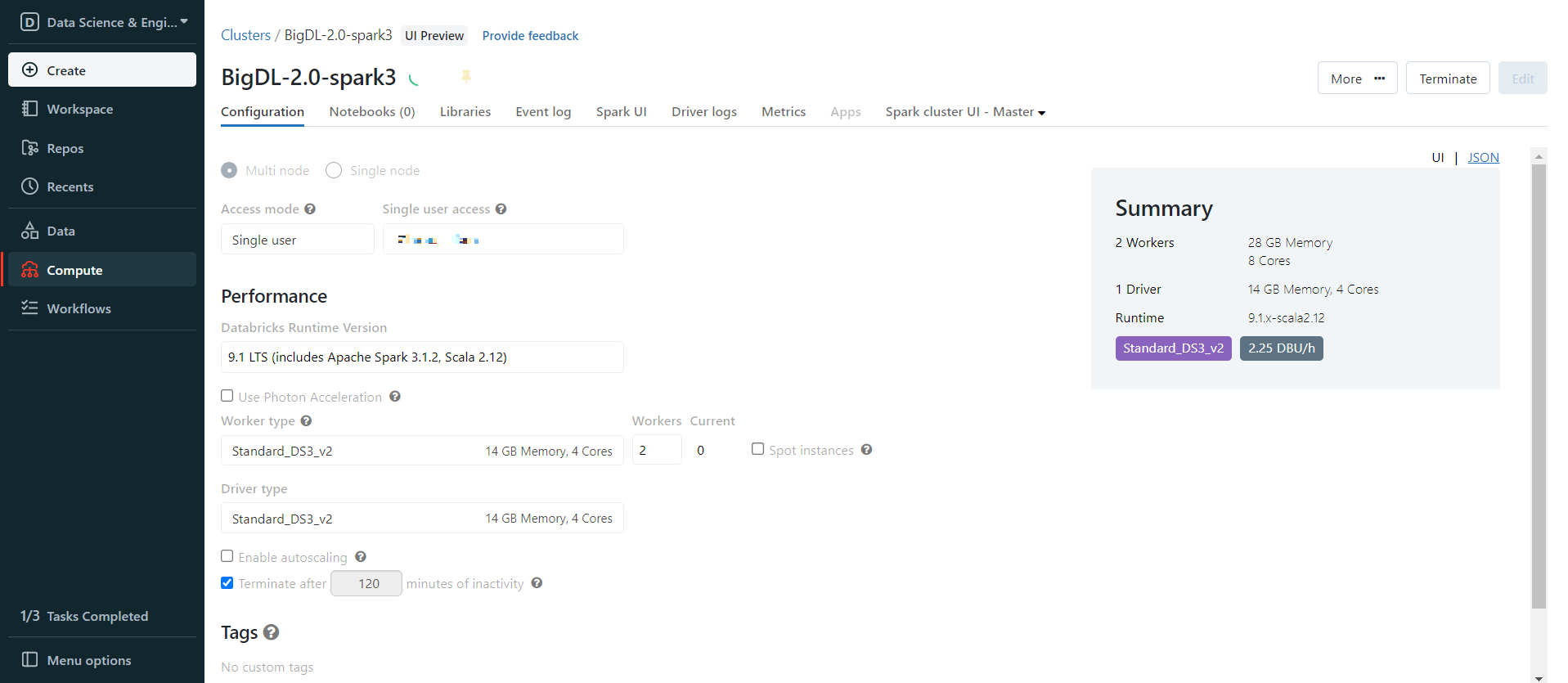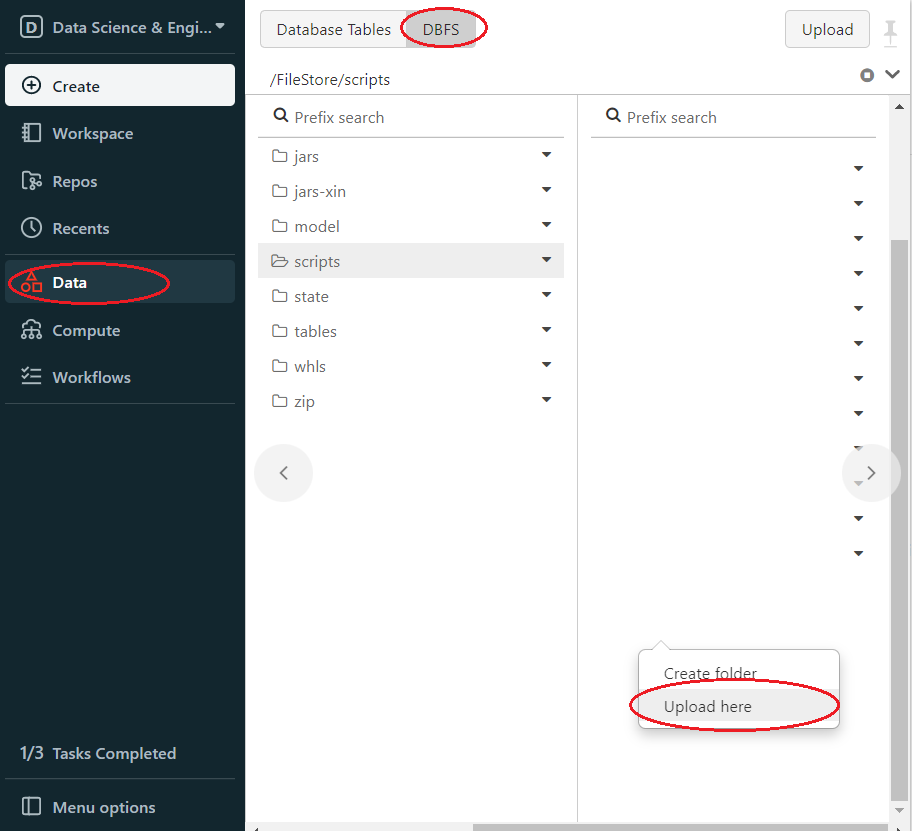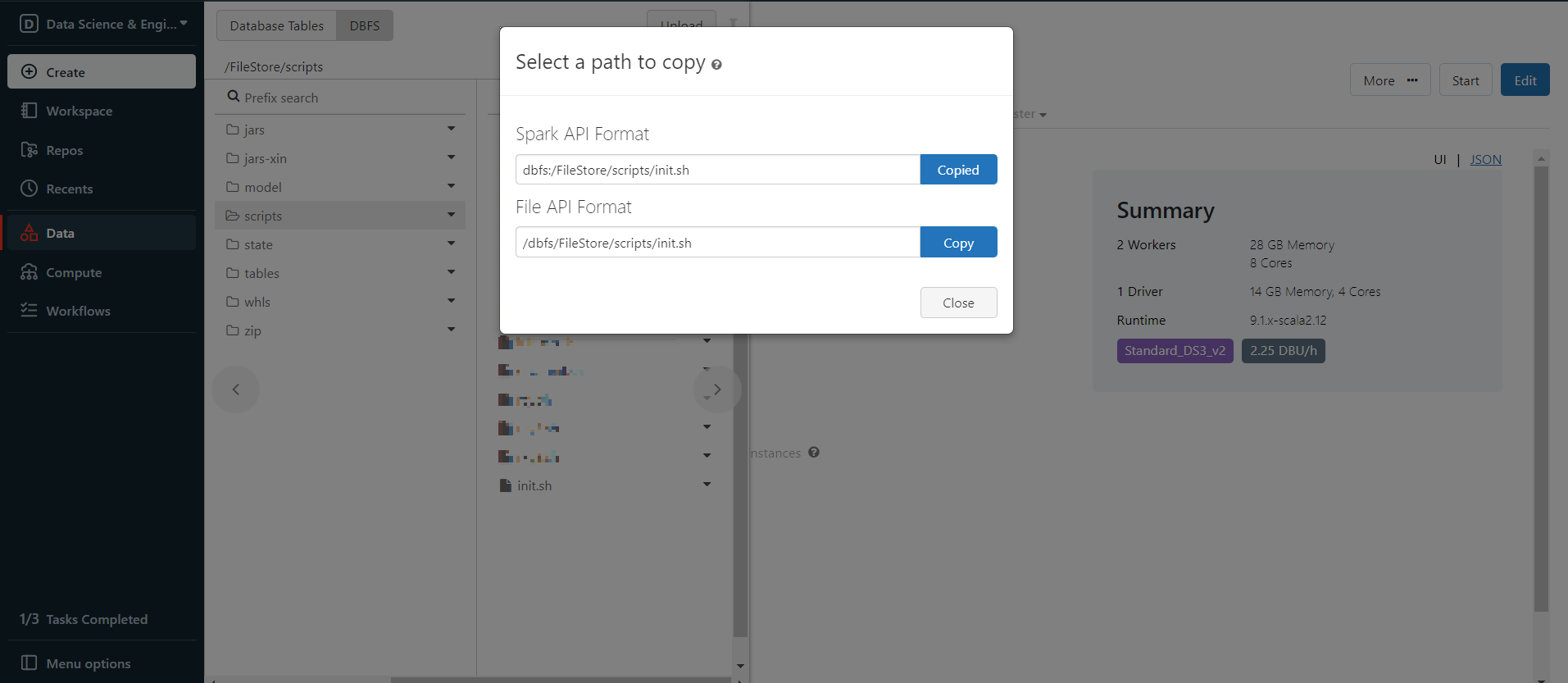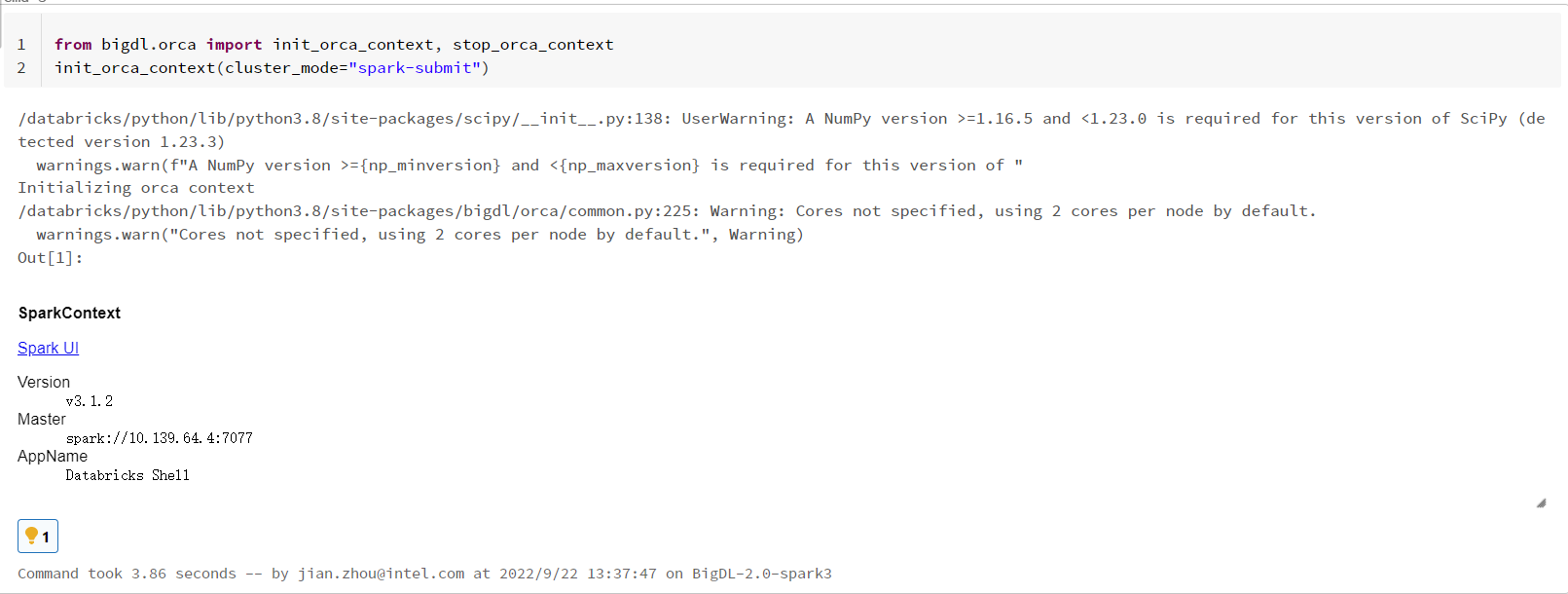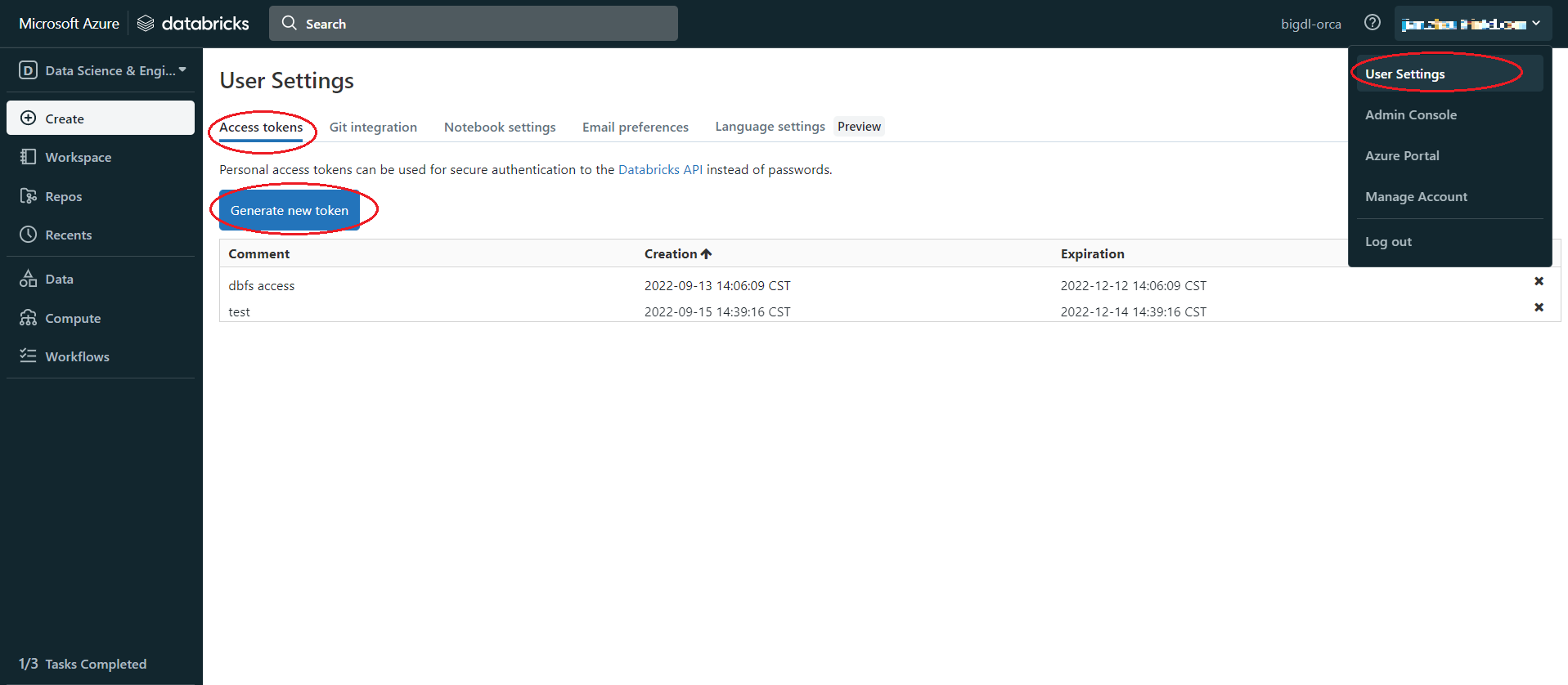* update databricks doc * update databricks doc * update databricks doc * update databricks doc * update databricks doc * update databricks doc Co-authored-by: Zhou <jian.zhou@intel.com>
11 KiB
Databricks User Guide
You can run BigDL program on the Databricks cluster as follows.
1. Create a Databricks Cluster
- Create either an AWS Databricks workspace or an Azure Databricks workspace.
- Create a Databricks cluster using the UI. Choose Databricks runtime version. This guide is tested on Runtime 9.1 LTS (includes Apache Spark 3.1.2, Scala 2.12).
2. Generate initialization script
Init script is used to Install BigDL or other libraries. First, you need to put the init script into DBFS, you can use one of the following ways.
a. Generate init script in Databricks notebook
Create a Databricks notebook and execute
init_script = """
#!/bin/bash
# install bigdl-orca, add other bigdl modules if you need
/databricks/python/bin/pip install pip install --pre --upgrade bigdl-orca-spark3[ray]
# install other necessary libraries, here we install libraries needed in this tutorial
/databricks/python/bin/pip install tensorflow==2.9.1
/databricks/python/bin/pip install pyarrow==8.0.0
/databricks/python/bin/pip install psutil
# copy bigdl jars to databricks
cp /databricks/python/lib/python3.8/site-packages/bigdl/share/*/lib/*.jar /databricks/jars
"""
# Change the first parameter to your DBFS path
dbutils.fs.put("dbfs:/FileStore/scripts/init.sh", init_script, True)
To make sure the init script is in DBFS, in the left panel, click Data > DBFS > check your script save path.
if you do not see DBFS in your panel, see Appendix A.
b. Create init script in local and upload to DBFS
Create a file init.sh(or any other filename) in your computer, the file content is
#!/bin/bash
# install bigdl-orca, add other bigdl modules if you need
/databricks/python/bin/pip install pip install --pre --upgrade bigdl-orca-spark3[ray]
# install other necessary libraries, here we install libraries needed in this tutorial
/databricks/python/bin/pip install tensorflow==2.9.1
/databricks/python/bin/pip install pyarrow==8.0.0
/databricks/python/bin/pip install psutil
# copy bigdl jars to databricks
cp /databricks/python/lib/python3.8/site-packages/bigdl/share/*/lib/*.jar /databricks/jars
Then upload init.sh to DBFS. In Databricks left panel, click Data > DBFS > Choose or create upload directory > Right click > Upload here.
Now the init script is in DBFS, right click the init.sh and choose Copy path, copy the Spark API Format path.
3. Set Spark configuration
In the left panel, click Compute > Choose your cluster > edit > Advanced options > Spark > Confirm. You can provide custom Spark configuration properties in a cluster configuration. Please set it according to your cluster resource and program needs.
See below for an example of Spark config setting needed by BigDL. Here it sets 2 core per executor. Note that "spark.cores.max" needs to be properly set below.
spark.executor.cores 2
spark.cores.max 4
4. Install BigDL Libraries
Use the init script from step 2 to install BigDL libraries. In the left panel, click Compute > Choose your cluster > edit > Advanced options > Init Scripts > Paste init script path > Add > Confirm.
Then start or restart the cluster. After starting/restarting the cluster, the libraries specified in the init script are all installed.
5. Run BigDL on Databricks
Open a new notebook, and call init_orca_context at the beginning of your code (with cluster_mode set to "spark-submit").
from bigdl.orca import init_orca_context, stop_orca_context
init_orca_context(cluster_mode="spark-submit")
Output on Databricks:
Run ncf_train example on Databricks
Create a notebook and run the following example. Note that to make things simple, we are just generating some dummy data for this example.
import math
import argparse
import os
import random
from bigdl.orca import init_orca_context, stop_orca_context, OrcaContext
from bigdl.orca.learn.tf2.estimator import Estimator
from pyspark.sql.types import StructType, StructField, IntegerType
def build_model(num_users, num_items, class_num, layers=[20, 10], include_mf=True, mf_embed=20):
import tensorflow as tf
from tensorflow.keras.layers import Input, Embedding, Dense, Flatten, concatenate, multiply
num_layer = len(layers)
user_input = Input(shape=(1,), dtype='int32', name='user_input')
item_input = Input(shape=(1,), dtype='int32', name='item_input')
mlp_embed_user = Embedding(input_dim=num_users, output_dim=int(layers[0] / 2),
input_length=1)(user_input)
mlp_embed_item = Embedding(input_dim=num_items, output_dim=int(layers[0] / 2),
input_length=1)(item_input)
user_latent = Flatten()(mlp_embed_user)
item_latent = Flatten()(mlp_embed_item)
mlp_latent = concatenate([user_latent, item_latent], axis=1)
for idx in range(1, num_layer):
layer = Dense(layers[idx], activation='relu',
name='layer%d' % idx)
mlp_latent = layer(mlp_latent)
if include_mf:
mf_embed_user = Embedding(input_dim=num_users,
output_dim=mf_embed,
input_length=1)(user_input)
mf_embed_item = Embedding(input_dim=num_users,
output_dim=mf_embed,
input_length=1)(item_input)
mf_user_flatten = Flatten()(mf_embed_user)
mf_item_flatten = Flatten()(mf_embed_item)
mf_latent = multiply([mf_user_flatten, mf_item_flatten])
concated_model = concatenate([mlp_latent, mf_latent], axis=1)
prediction = Dense(class_num, activation='softmax', name='prediction')(concated_model)
else:
prediction = Dense(class_num, activation='softmax', name='prediction')(mlp_latent)
model = tf.keras.Model([user_input, item_input], prediction)
return model
if __name__ == '__main__':
executor_cores = 2
lr = 0.001
epochs = 5
batch_size = 8000
model_dir = "/dbfs/FileStore/model/ncf/"
backend = "ray" # ray or spark
data_dir = './'
save_path = model_dir + "ncf.h5"
sc = init_orca_context(cluster_mode="spark-submit")
spark = OrcaContext.get_spark_session()
num_users, num_items = 6000, 3000
rdd = sc.range(0, 50000).map(
lambda x: [random.randint(0, num_users - 1), random.randint(0, num_items - 1), random.randint(0, 4)])
schema = StructType([StructField("user", IntegerType(), False),
StructField("item", IntegerType(), False),
StructField("label", IntegerType(), False)])
data = spark.createDataFrame(rdd, schema)
train, test = data.randomSplit([0.8, 0.2], seed=1)
config = {"lr": lr, "inter_op_parallelism": 4, "intra_op_parallelism": executor_cores}
def model_creator(config):
import tensorflow as tf
model = build_model(num_users, num_items, 5)
print(model.summary())
optimizer = tf.keras.optimizers.Adam(config["lr"])
model.compile(optimizer=optimizer,
loss='sparse_categorical_crossentropy',
metrics=['sparse_categorical_crossentropy', 'accuracy'])
return model
steps_per_epoch = math.ceil(train.count() / batch_size)
val_steps = math.ceil(test.count() / batch_size)
estimator = Estimator.from_keras(model_creator=model_creator,
verbose=False,
config=config,
backend=backend,
model_dir=model_dir)
estimator.fit(train,
batch_size=batch_size,
epochs=epochs,
feature_cols=['user', 'item'],
label_cols=['label'],
steps_per_epoch=steps_per_epoch,
validation_data=test,
validation_steps=val_steps)
predictions = estimator.predict(test,
batch_size=batch_size,
feature_cols=['user', 'item'],
steps=val_steps)
print("Predictions on validation dataset:")
predictions.show(5, truncate=False)
print("Saving model to: ", save_path)
estimator.save(save_path)
# load with estimator.load(save_path)
stop_orca_context()
6. Other ways to install third-party libraries on Databricks if necessary
If you want to use other ways to install third-party libraries, check related Databricks documentation of libraries for AWS Databricks and libraries for Azure Databricks.
Appendix A
If there is no DBFS in your panel, go to User profile > Admin Console > Workspace settings > Advanced > Enabled DBFS File Browser
Appendix B
Use Databricks CLI to upload file to DBFS. When you upload a large file to DBFS, using Databricks CLI could be faster than using the Databricks web UI.
Install and config Azure Databricks CLI
-
Install Python, need Python version 2.7.9 and above if you’re using Python 2 or Python 3.6 and above if you’re using Python 3.
-
Run
pip install databricks-cli -
Set authentication, Click user profile icon > User Settings > Access tokens > Generate new token > generate > copy the token, make sure to copy the token and store it in a secure location, it won't show again.
-
Copy the URL of Databricks host, the format is
https://adb-<workspace-id>.<random-number>.azuredatabricks.net, you can copy it from your Databricks web page URL. -
In cmd run
dbfs config --tokenas shown below:dbfs configure --token Databricks Host (should begin with https://): https://your.url.from.step.4 Token: your-token-from-step-3 -
Verify whether you are able to connect to DBFS, run "databricks fs ls".
Upload through Databricks CLI
Now, we can use Databricks CLI to upload file to DBFS. run command:
dbfs cp /your/local/filepath/bigdl-assembly-spark_3.1.2-2.1.0-SNAPSHOT-jar-with-dependencies.jar dbfs:/FileStore/jars/stable/bigdl-assembly-spark_3.1.2-2.1.0-SNAPSHOT-jar-with-dependencies.jar
After command finished, check DBFS in Databricks, in left panel, click Data > DBFS > your upload directory, if you do not see DBFS in your panel, see Appendix A.
Install package from DBFS
In the left panel, click Compute > choose your cluster > Libraries > Install new > Library Source(DBFS/ADLS) > Library Type(your package type).
